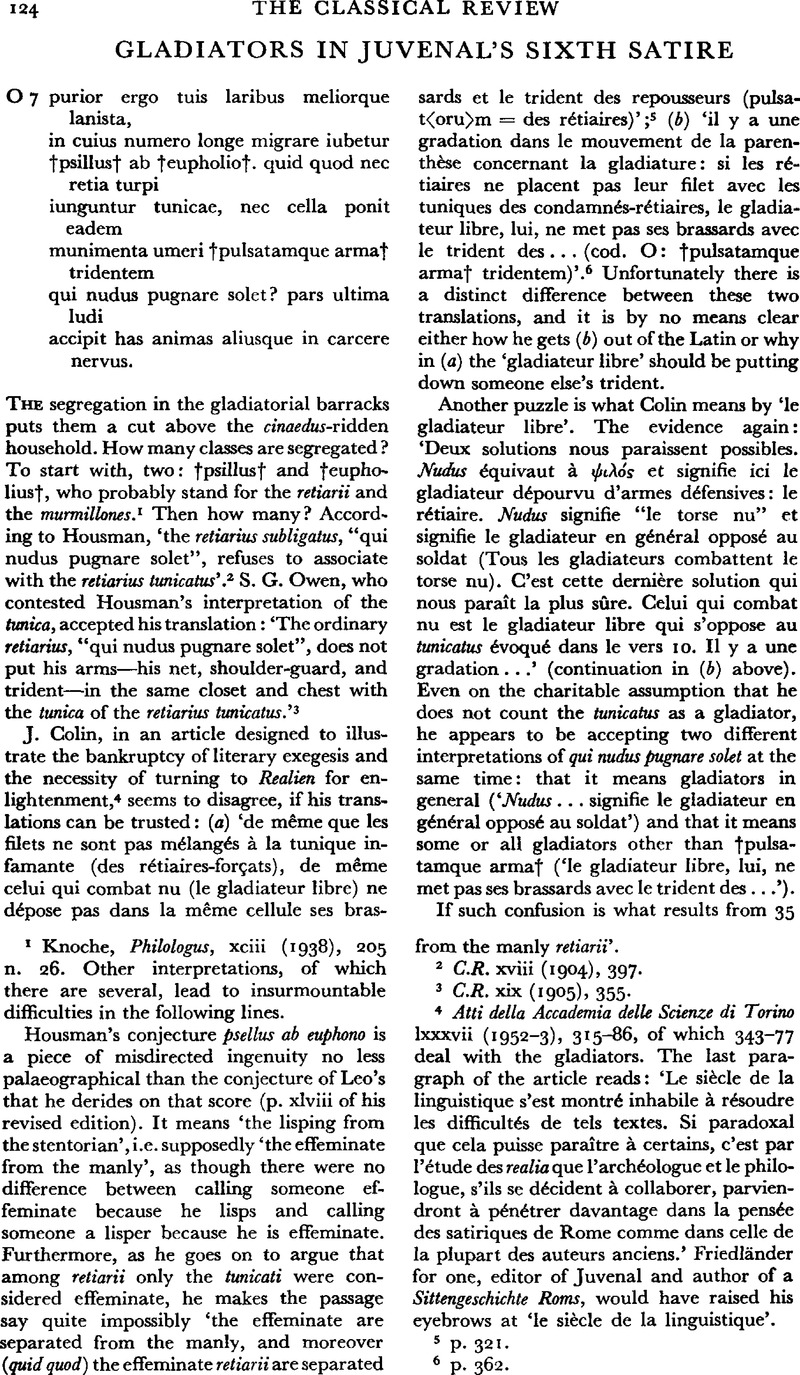Published online by Cambridge University Press: 27 February 2009

page 124 note 1 Knoche, , Philologus, xciii (1938), 205 n. 26Google Scholar. Other interpretations, of which there are several, lead to insurmountable difficulties in the following lines.
Housman's conjecture psellus ab euphono is a piece of misdirected ingenuity no less palaeographical than the conjecture of Leo's that he derides on that score (p. xlviii of his revised edition). It means ‘the lisping from the stentorian’, i.e. supposedly ‘the effeminate from the manly’, as though there were no difference between calling someone effeminate because he lisps and calling someone a lisper because he is effeminate. Furthermore, as he goes on to argue that among retiarii only the tunicati were considered effeminate, he makes the passage say quite impossibly ‘the effeminate are separated from the manly, and moreover (quid quod) the effeminate retiarii are separated is from the manly retiarii’.
page 124 note 2 C.R. xviii (1904), 397.Google Scholar
page 124 note 3 C.R. xix (1905), 355.Google Scholar
page 124 note 4 Atti della Accademia delle Scienze di Torino lxxxvii (1952–1953), 315–386Google Scholar, of which 343–77 deal with the gladiators. The last paragraph of the article reads: ‘Le siècle de la linguistique s'est montré inhabile à résoudre les difficultés de tels textes. Si paradoxal que cela puisse paraître à certains, c'est par l'étude des realia que l'archéologue et le philologue, s'ils se décident à collaborer, parviendront à pénétrer davantage dans la pensée des satiriques de Rome comme dans celle de la plupart des auteurs anciens.’ Friedländer for one, editor of Juvenal and author of a Sittengeschichte Roms, would have raised eyebrows at ‘le siècle de la linguistique’.
page 124 note 5 P. 321.
page 124 note 6 p. 362.
page 125 note 1 The Latin could mean that the man who fights naked puts his shoulder-guard and his trident in different places, but no one has ever been attracted by that interpretation. Cf. Housman's original translation in C.R. xiii (1899), 266Google Scholar, which led him to declare the passage ‘absurdly frivolous’: ‘The retiarius' net is not kept with his tunic, nor does he put his galerus in the same cupboard as his trident.’ Two years later the absurdity was too much for him, and in C.R. xv (1901), 263–264Google Scholar, convinced that ‘the words as they stand are incapable of any other meaning’, he proposed an impossible emendation (turpi 〈et〉). Only when he learned that not all retiarii wore a tunic did he change his mind and adopt the translation cited in the first paragraph of this article. In fact he need not have departed so far from his original translation, because the sentence could mean ‘nets are not kept with the disreputable tunic (i.e. the retiarius tunicatus keeps his net and his tunic separate), and the man who fights naked puts his shoulder-guard and his trident in different places’. Anyone who believes that is what the author intended can ignore the rest of this article, at the cost of admitting that the passage is as frivolous as Housman first thought.
page 125 note 2 All scholars who have discussed the passage hold that the tunic belongs to some class of retiarii (other wearers of the tunic in the arena are listed by Colin, 348–50).
Though Suet. Cal. 30. 3 is incontrovertible evidence that a tunic could be worn by and retiarii, the monuments seldom show them wearing one. See, however, Krüger, E., Römisch-germanische Korrespondenzblatt, viii (1915), 20–22Google Scholar; Abb. 10, 16, 16a, of Wollmann, H., Röm. Mitt, xxxii (1917), 147–167Google Scholar; fig. 8 and plate VIII. 1 of Faccenna, Bullettino del Museo della Civiltà Romana, xix. 37–75, in Bull. Comm. Arch. Com. di Roma, Ixxvi (1956–8, pub. 1959).
The mosaic of the retiarius Kalendio, printed from a drawing by Winckelmann, Morutmenti Antichi Inediti2 (Rome, 1821), ii, plate 197, and partly reproduced from Winckelmann by Daremberg–Saglio, s.v. Gladiator, p. 1586 fig. 3581, and Colin, 365, fig. 6, can be found photographed in Freijeiro, Archivo Español de Arqueologia, xxiii (1950) 127–42 fig. 8. Judging from an earlier photograph, Krüger, op. cit., p. 21, doubted whether Kalendio wears a tunic, and certainly in the upper scene (not reproduced by Daremberg–Saglio and Colin) he is bare above the waist; but in the lower scene, though his right shoulder is bare, his left arm is wrapped in what seems to be part of the garment that covers his loins. If the two scenes are to be reconciled, he must be wearing a tunic that begins at the outset of the fight by leaving his right shoulder bare (cf. esp. Faccenna, fig. 8) and ends in disarray when he lies defeated; but as he appears to have acquired some protection for his ankles between the earlier scene and the later, perhaps it is a mistake to look for consistency.